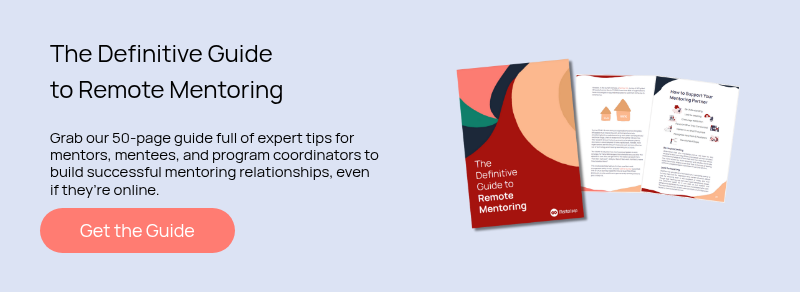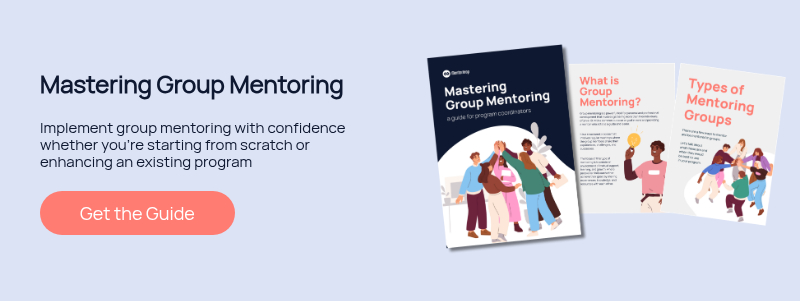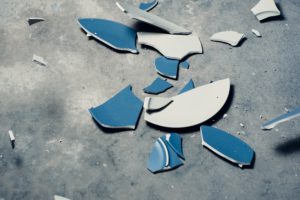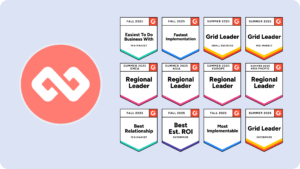Mentoring programs have become a staple in many organizations, particularly for those employees deemed ‘high potentials’ (HiPos). But what does this designation really mean, and are these exclusive programs as effective as we assume?
In this article, we explore the definition of high potential, examine the pitfalls of HiPo-only mentoring initiatives, and make the case for a more inclusive approach, one that recognizes the untapped talent across your entire workforce.
What does ‘High Potential’ really mean in the workplace?
In the corporate world, the term ‘high potential’ refers to employees who are seen as having the capability to grow into leadership roles. These individuals typically demonstrate exceptional performance, strong problem-solving skills, and have a reputation for being “future-ready.”
According to the Harvard Business Review (HBR), companies tend to think of HiPos as the top 3-5% of their talent:
“High potentials consistently and significantly outperform their peer groups in a variety of settings and circumstances. While achieving these superior levels of performance, they exhibit behaviours that reflect their companies’ culture and values in an exemplary manner. Moreover, they show a strong capacity to grow and succeed throughout their careers within an organisation—more quickly and effectively than their peer groups do.”
Essentially, HiPos:
- Deliver strong results—credibly,
- Master new types of expertise,
- Recognise that behaviour counts, and
- Have an “X” factor: A drive to excel, a catalytic learning capability, an enterprising spirit, dynamic sensors, etc.
But is this definition too narrow? What criteria should organizations use to identify HiPos?
Traditionally, HiPos are identified based on their past performance and the potential they exhibit for future success. However, this approach can sometimes overlook valuable traits that contribute to long-term success, such as emotional intelligence, collaboration skills, and the ability to inspire others. As organizations strive to cultivate a diverse leadership pipeline, we think it’s time to expand the criteria used to define high potential.
How HiPos are traditionally identified
Most organizations rely on performance reviews, peer feedback, and leadership assessments to identify HiPos. This method often leads to prioritizing hard metrics, such as sales figures or project completion rates. While these indicators are important, they may not fully capture an employee’s potential for growth and leadership, especially with skills like empathy, collaboration, and influence proving to be increasingly vital in modern leadership
Furthermore, the reliance on subjective assessments can introduce bias into the evaluation process. Are we truly recognizing the diverse talents within our workforce, or are we inadvertently favoring certain traits and backgrounds? Are we selecting HiPos based on genuine potential or simply on who looks and sounds like existing leadership?
HiPos and succession planning
Succession planning is a critical aspect of organizational strategy, ensuring that there are capable leaders ready to step into key roles as they become available. HiPos are often at the forefront of these plans. While this makes strategic sense, it also raises a question: what happens to everyone else, especially those who don’t fit the current or tradiitional mold?
Effective succession planning should cast a wider net, recognizing that leadership can come from unexpected places, across departments, demographics, and even experience levels. Relying on a narrow view of potential limits your leadership pipeline and makes an organization less adaptable. By expanding the definition of HiPos, organizations can create a more resilient and adaptable leadership team that reflects the diversity of their workforce.
Why HiPo-only mentoring programs often miss the mark
Workplace solution provider SHL found that HiPos bring 91% more value to an organisation than non-HiPos. So it might seem efficient and strategically sound to hyper focus on investing in their development over everyone else. However, SHL also found that 73% of HiPo programs fail to deliver business outcomes and ROI.
So what’s the issue?
Mentoring high potentials isn’t the issue. The issue is mentoring only high potentials.
Built-in biases and lack of diversity
One of the most significant challenges with HiPo-only mentoring programs is the potential for built-in biases. HiPo pools often reflect existing power structures and traditional mentoring programs often favor the bold.
And when organizations limit mentoring opportunities to this specific group, they risk perpetuating existing inequalities and just reinforcing homogeneity at the top. It alienates talented individuals who may not fit the traditional HiPo criteria but possess unique skills and perspectives.
As we mentioned in a previous post, HBR found that while white men tend to find mentors on their own, women and minorities more often need help from formal programs. Why is this? HBR cites Georgetown’s former business school dean David Thomas, who found that “white male executives don’t feel comfortable reaching out informally to young women and minority men”. However, if it’s within a structured mentoring program, this changes: “They are eager to mentor assigned protégés, and women and minorities are often first to sign up for mentors”.
What all this means is that by only giving HiPos mentoring opportunities, the organization misses out on diverse voices and perspectives that lead to better decision-making.
Confusing performance with potential
It’s not uncommon for organizations to confuse performance with potential.
Just because an employee excels in their current role, it does not necessarily mean they will thrive in a leadership position. This misunderstanding can result in organizations investing resources in individuals who may not be suited or ready for higher-level responsibilities.
As Forbes notes, “One of the main reasons why HiPo programs fail is that they focus too much—sometimes exclusively—on performance.”
Author Tomas Chamorro-Premuzic goes on to note this is problematic for two reasons:
Businesses are usually not very good at measuring performance, and
Even if they are good at measuring performance, many top performers will fail to perform well at the next level.
Think of it this way: When you transition employees from individual contributors to managers, or from managers to leaders, the pivotal qualities or competencies that drive high-performance change. Furthermore, many strong individual contributors are not even interested in managing or leading others, preferring instead to focus on independent problem-solving or being a team-player. The result is a paradoxical system that removes people from a job they are rather good at, and re-positions them in a role they are neither able or willing to do.
Performance is what you’ve done. Potential is what you could do, especially with the right support.
If the role someone is being moved into does not build on the skills they have mastered in his or her current role, the skills they are performing well, there’s no way to know that the same level of mastery will be attained in the new role. Therefore, it’s important to understand the difference between performance and potential, and realise there might be someone better for the open position, someone you might not have considered.
And seeing as 95% of organisations are ineffective at following through on action plans to help individuals develop for new roles, how can you successfully close the gap between potential and performance? SHL found that “on-the-job learning has two and a half times the impact on engagement and three times the impact on performance than traditional training.”
So by providing clear career paths and offering structured development opportunities that match personal career goals, the organization can increase employee engagement and performance.
And what’s a great way to accomplish both? Building a culture of mentoring at your organisation.
Mentoring should help people grow, not just reward past achievements. Organizations should focus on identifying potential through a more holistic lens. This means assessing not just past performance but also the employee’s ability to learn, adapt, and grow in new environments.
Morale, motivation, and cultural fallout
Exclusivity in mentoring programs can send the message that only certain people are worth investing in. It can lead to decreased morale among employees who feel overlooked or undervalued. When only a select few are given access to mentorship, it can create a culture of competition rather than collaboration. This environment may discourage employees from sharing ideas or seeking help from one another. It also lowers morale and drives disengagement, especially among talented individuals who aren’t selected but still have growth aspirations.
Lost opportunities for broader talent development
By concentrating solely on HiPos, organizations miss out on the opportunity to develop a wider range of talent and risk overlooking incredible potential across the organization. Every employee has unique strengths and experiences that can contribute to the organization’s success. And not to mention, innovation, collaboration, and resilience often come from those working behind the scenes.
When mentoring is restricted to a select few, organizations miss out on valuable insights and innovative ideas from both the broader team and those individuals who are less likely to promote their own achievements.
Expanding mentoring programs to include all employees can lead to a more engaged workforce, where individuals feel valued and empowered to contribute. It also allows you to develop future leaders from every corner of your organization.
Making mentoring work for everyone: The case for inclusivity
The real power of mentoring lies in scale. When you make mentoring more inclusive, the benefits ripple out: improved engagement, stronger collaboration, higher retention, and a culture where everyone feels valued and invested in.
Widening access without lowering standards
Inclusive mentoring isn’t about lowering the bar; it’s about expanding the playing field by broadening the criteria for participation.
Organizations can create tiered mentoring programs that cater to different levels of experience and expertise, allowing employees to engage in mentorship that aligns with their career goals.
Building belonging and engagement at scale
When mentoring programs are inclusive, they foster a sense of belonging among employees. This sense of community can lead to increased engagement and job satisfaction, as individuals feel valued and supported in their professional journeys. And when people feel seen and supported, they stay longer, contribute more, and grow faster. Broadening access to mentoring helps create a culture where development is part of everyone’s journey, not just the privileged few.
Knowledge sharing and cross-pollination thrive in open systems
Inclusive programs encourage knowledge flow across departments, levels, and backgrounds. When employees from different backgrounds and experiences come together, they can challenge each other’s thinking and inspire new solutions which brings about creativity and innovation.
Reverse mentoring, peer-to-peer support, and intergenerational exchanges all become possible when everyone is encouraged to participate in mentoring relationships. Ultimately, this breeds a mentoring culture within an organization, leading to smarter, more agile teams.
Unlocking untapped talent across the business
Many organizations have untapped talent within their ranks, waiting to be discovered. And many of them don’t look like the HiPo archetype.
Inclusive mentoring helps surface talent hidden by structural barriers or lack of visibility, people who might never have been “nominated” but thrive when given support.
This helps develop these individuals, providing them with the support and guidance they need to thrive, which ultimately benefits the organization as a whole.
Developing stronger leaders
Investing in programs that accurately identify and successfully develop not just HiPos, but a diverse array of team members, helps your organization create stronger, more successful leaders.
By giving everyone opportunities to mentor and be mentored, not only do employees acquire valuable job-related information, you also allow allow a diverse pool of mentors to serve as role models that motivate their mentoring partners to, as Plum notes, “obtain valuable knowledge to promote a successful career”.
Driving stronger business outcomes
Research has shown that diverse, engaged teams innovate more and deliver better results than their homogeneous counterparts. By implementing inclusive mentoring programs, organizations can drive stronger business outcomes and create a competitive advantage in the marketplace.
Inclusive mentoring in action: What good looks like
To truly realize the benefits of inclusive mentoring, organizations must implement mentoring practices that promote accessibility and engagement. So what does effective inclusive mentoring look like in practice?
Tiered or self-nominated programs
Let employees raise their hand. Whether they’re early in their career or ready to lead, mentoring should be opt-in, not exclusive. Tiered or self-nominated mentoring programs allow for targeted development without gatekeeping.
It allows employees to choose the level of mentorship that best suits their needs and aspirations, empowering individuals to take charge of their development.
Self-nomination also encourages employees to seek out mentors who align with their career goals, leading to more meaningful and productive mentoring relationships.
Replace gatekeeping with smarter matching
Rather than relying on gatekeeping practices to determine who gets access to mentorship, organizations should focus on smarter mentor-mentee matching. This involves pairing mentors and mentees based on shared interests, goals, and experiences by using data, not hierarchy.
By utilizing technology and data-driven approaches, organizations can enhance the matching process, ensuring that mentorship opportunities are tailored to the unique needs of each employee, fostering more authentic connections.
From performance tool to culture strategy
Finally, organizations should view mentoring not just as a performance tool but as a vital component of their culture strategy. By embedding mentoring into the fabric of the organization, leaders can create an environment where learning and development are prioritized and celebrated.
Mentoring shouldn’t just be a tool for grooming HiPos. When mentoring becomes part of how your organization operates, its impact compounds on individuals, teams, and business outcomes.
Unlock the full potential of your workforce
Ultimately, mentoring shouldn’t just be for high potentials, as not only can everyone benefit, but so does the entire organisation. Building a culture of mentorship can provide support, develop talent, inspire commitment and engagement, improve retention, and foster an environment of continuous learning and progress, all while making your succession planning all the more effective.
Ready to elevate your organization and foster a culture that thrives on growth and development? At Mentorloop, we’re committed to helping you streamline and enhance the mentorship experience. Mentorloop is designed to support, not just your high potentials but your entire team, ensuring no one is left behind.
Book a demo today and see how Mentorloop can transform your approach to mentorship, driving better outcomes and a more inclusive workplace.


![[Webinar Kit] Turnover Threat into Talent Triumph: Designing a mentoring program that boosts employee engagement Learn how to design a high-impact mentoring program that helps you achieve your employee engagement goals.](https://no-cache.hubspot.com/cta/default/4058869/interactive-189625368503.png)





